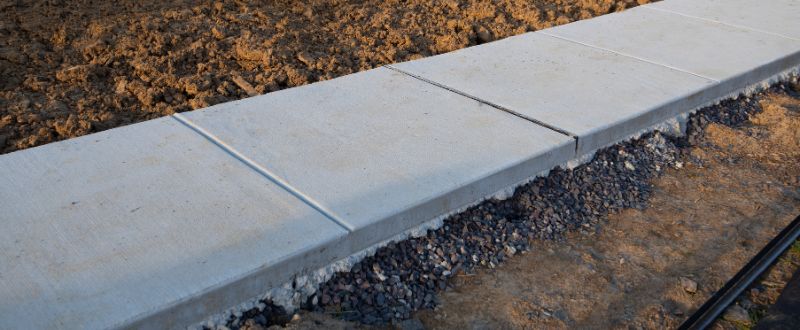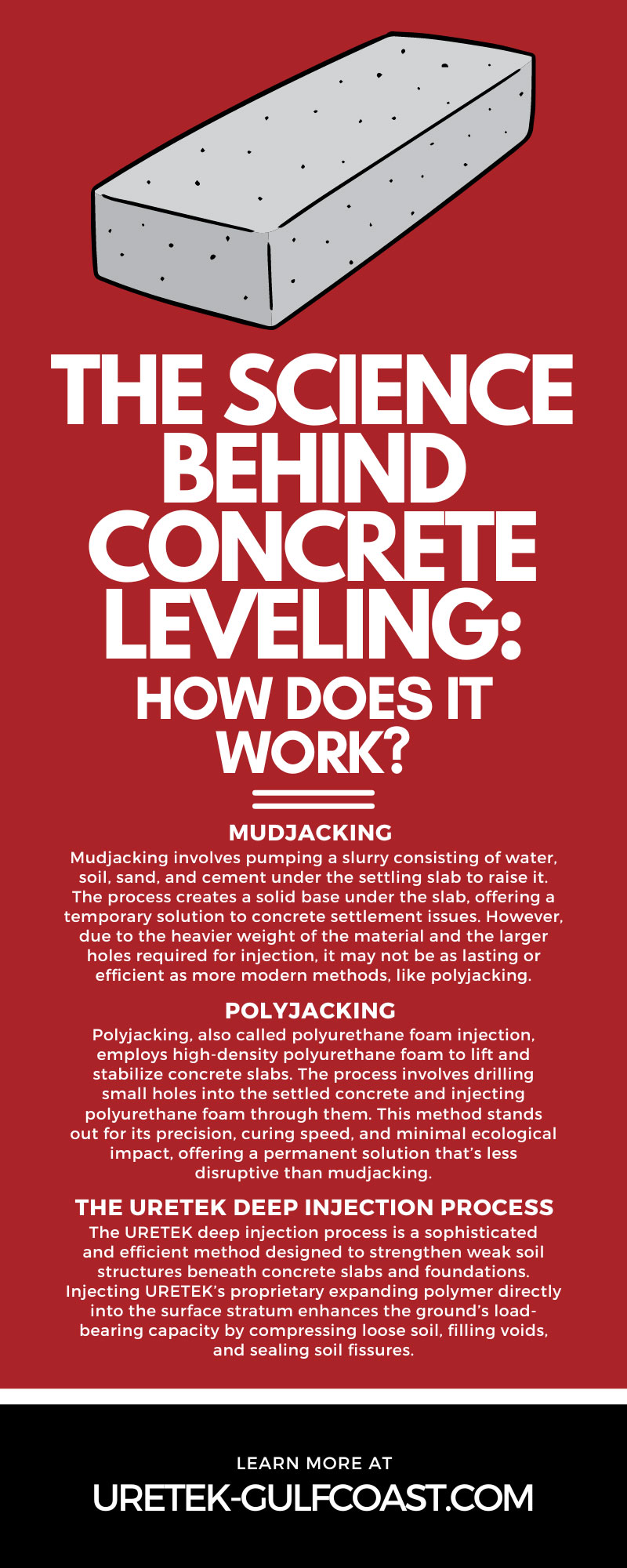Concrete leveling corrects uneven concrete surfaces without the need for complete slab replacement. This innovative approach not only saves time and reduces costs but also minimizes disruption to the surrounding area, making it a preferred solution for both residential and commercial properties.
Explore the processes, materials, and outcomes associated with concrete leveling. Understanding the science behind how concrete leveling works explains why polyurethane foam injection stands as a superior choice for addressing settlement issues.
The Causes of Concrete Settlement
Concrete settlement refers to the process where slabs of concrete begin to sink or shift, often creating uneven surfaces.
The following factors may cause foundations or concrete to settle:
- Soil erosion beneath the concrete slab can lead to cavities or voids, causing the slab to settle.
- The natural settling of soil over time, especially if the soil was not properly compacted during construction, can lead to uneven concrete surfaces.
- Excessive moisture from rain, flooding, or poor drainage can soften the ground and undermine the concrete’s foundation.
- The freeze-thaw cycle can expand and contract the soil underneath the concrete, leading to displacement and settling.
Hazards of Concrete Settlement
Uneven concrete poses significant safety hazards, including the risk of trips and falls. Settlement can also lead to water pooling in undesirable areas, potentially causing damage to the structure or the surrounding landscape. Furthermore, uneven concrete detracts from the aesthetic value of a property, potentially reducing its market appeal and overall value. If neglected, the damage can escalate, leading to more complex and expensive repairs down the line.
Given these risks, it is paramount to choose the right technique for repairing settled concrete to ensure long-term stability and safety. Selecting a repair method that combines efficiency with effectiveness can prevent future issues, offering peace of mind and protecting your investment.
Comparing Concrete Leveling Methods
Property owners can choose between two concrete leveling methods: mudjacking and polyjacking. Compare the characteristics of each before learning more about how polyjacking works.
Mudjacking
Mudjacking involves pumping a slurry consisting of water, soil, sand, and cement under the settling slab to raise it. The process creates a solid base under the slab, offering a temporary solution to concrete settlement issues. However, due to the heavier weight of the material and the larger holes required for injection, it may not be as lasting or efficient as more modern methods, like polyjacking.
Polyjacking
Polyjacking, also called polyurethane foam injection, employs high-density polyurethane foam to lift and stabilize concrete slabs. The process involves drilling small holes into the settled concrete and injecting polyurethane foam through them. This method stands out for its precision, curing speed, and minimal ecological impact, offering a permanent solution that’s less disruptive than mudjacking.
Chemical Reactions and Expanding Foam
The science behind how polyurethane concrete leveling works depends primarily on the chemical reactions and material makeup. URETEK’s patented high-density polyurethane is made up of two components—a polymeric diphenylmethane diisocyanate and a patented polyurethane polyol blend. When these two materials mix at the tip of the injector, they produce an exothermic reaction and expand.
The foam is both lightweight and robust, filling voids in the soil and providing an upward force sufficient to lift the concrete slab to a more level position. The cured foam creates a stable, durable support with minimal environmental impact. The efficiency of this process, coupled with its longevity, makes polyurethane foam an outstanding solution in the realm of concrete leveling.
The URETEK Deep Injection Process
The URETEK deep injection process is a sophisticated and efficient method designed to strengthen weak soil structures beneath concrete slabs and foundations. Injecting URETEK’s proprietary expanding polymer directly into the surface stratum enhances the ground’s load-bearing capacity by aggregating and densifyiloose soil, filling voids, and sealing soil fissures.
Upon reaching a critical expansion point, known as the point of refusal, the polymer lifts the settled structures, improving alignment and stability. Throughout the injection and lifting procedure, expansion is meticulously monitored using pressure dials, laser levels, and computer-assisted leveling devices for accurate and efficient restoration.
Characteristics of URETEK’s Patented Foam
The URETEK deep injection process utilizes a patented expanding polyurethane foam. This advanced foam is fast-curing, hydro-insensitive, and environmentally friendly, aligning with our commitment to sustainable and efficient concrete leveling solutions.
Fast-Curing
Upon application, the polymer reaches an impressive 90 percent of its full strength within just 15 minutes. This rapid curing process is a game-changer for businesses and homeowners alike, significantly reducing downtime and minimizing disruption. Foam application typically takes one day to complete and doesn’t require excavation or loud machinery.
Hydro-Insensitive
URETEK’s patented polymer stands out for its exceptional hydro-insensitive properties, ensuring it maintains compressive strength even when introduced directly into environments with flowing water. This characteristic makes our materials ideally suited for foundation repair in Houston. Whether dealing with soggy soils or spaces prone to water intrusion, our polymer reliably expands and cures to full strength, unaffected by the presence of water.
Environmentally Friendly
URETEK’s polymer materials are EPA-approved, aligning with the highest standards of environmental safety and regulatory compliance. They contain no CFCs (chlorofluorocarbons) or HFCs (hydrofluorocarbons), which are substances known for their ozone-depleting effects. This responsible formulation underscores our dedication to providing construction and repair solutions that are not only efficient and durable but also conscientiously minimize environmental impact.
Concrete Leveling vs. Slab Replacement
When evaluating the advantages of concrete leveling over slab replacement, the differences in cost and disruption become glaringly evident. Concrete leveling with polyurethane foam injection typically incurs significantly lower expenses compared to the labor, material, and waste disposal costs associated with slab replacement. Additionally, the leveling process is far less invasive, allowing businesses and homeowners to avoid the extensive downtime and inconvenience that come with tearing out and replacing concrete.
Furthermore, concrete leveling not only offers a cost-effective solution but also extends the service life of existing slabs, making it a sustainable choice. Unlike slab replacement, which can be subject to weather delays and long curing times for new concrete, leveling delivers immediate, durable results. These benefits show how polyjacking aligns with the needs of clients seeking rapid, reliable, and responsible repair solutions.
Polyjacking improves the levelness of settled concrete with efficiency, precision, and minimal environmental impact. The URETEK deep injection process is a cutting-edge solution that ensures long-lasting stability and alignment of concrete structures, providing a sustainable alternative to traditional slab replacement. Invest in the stability of your home, business, or concrete structure with polyurethane foam injection from URETEK ICR Gulf Coast.


